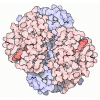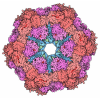[English] 日本語
 Yorodumi
Yorodumi- PDB-6oge: Cryo-EM structure of Her2 extracellular domain-Trastuzumab Fab-Pe... -
+ Open data
Open data
- Basic information
Basic information
| Entry | Database: PDB / ID: 6oge | |||||||||
|---|---|---|---|---|---|---|---|---|---|---|
| Title | Cryo-EM structure of Her2 extracellular domain-Trastuzumab Fab-Pertuzumab Fab complex | |||||||||
 Components Components |
| |||||||||
 Keywords Keywords | transferase/immune system / Her2 extracellular domain / Trastuzumab / Pertuzumab / transferase-immune system complex | |||||||||
| Function / homology |  Function and homology information Function and homology informationnegative regulation of immature T cell proliferation in thymus / IgD immunoglobulin complex / ERBB3:ERBB2 complex / ERBB2-ERBB4 signaling pathway / GRB7 events in ERBB2 signaling / IgA immunoglobulin complex / RNA polymerase I core binding / IgM immunoglobulin complex / immature T cell proliferation in thymus / IgE immunoglobulin complex ...negative regulation of immature T cell proliferation in thymus / IgD immunoglobulin complex / ERBB3:ERBB2 complex / ERBB2-ERBB4 signaling pathway / GRB7 events in ERBB2 signaling / IgA immunoglobulin complex / RNA polymerase I core binding / IgM immunoglobulin complex / immature T cell proliferation in thymus / IgE immunoglobulin complex / semaphorin receptor complex / CD22 mediated BCR regulation / ErbB-3 class receptor binding / IgG immunoglobulin complex / motor neuron axon guidance / Sema4D induced cell migration and growth-cone collapse / Fc epsilon receptor (FCERI) signaling / regulation of microtubule-based process / Classical antibody-mediated complement activation / PLCG1 events in ERBB2 signaling / Initial triggering of complement / ERBB2-EGFR signaling pathway / enzyme-linked receptor protein signaling pathway / neurotransmitter receptor localization to postsynaptic specialization membrane / ERBB2 Activates PTK6 Signaling / neuromuscular junction development / ERBB2-ERBB3 signaling pathway / Drug-mediated inhibition of ERBB2 signaling / Resistance of ERBB2 KD mutants to trastuzumab / Resistance of ERBB2 KD mutants to sapitinib / Resistance of ERBB2 KD mutants to tesevatinib / Resistance of ERBB2 KD mutants to neratinib / Resistance of ERBB2 KD mutants to osimertinib / Resistance of ERBB2 KD mutants to afatinib / Resistance of ERBB2 KD mutants to AEE788 / Resistance of ERBB2 KD mutants to lapatinib / Drug resistance in ERBB2 TMD/JMD mutants / positive regulation of Rho protein signal transduction / positive regulation of MAP kinase activity / positive regulation of transcription by RNA polymerase I / ERBB2 Regulates Cell Motility / semaphorin-plexin signaling pathway / immunoglobulin mediated immune response / oligodendrocyte differentiation / FCGR activation / PI3K events in ERBB2 signaling / Role of LAT2/NTAL/LAB on calcium mobilization / positive regulation of protein targeting to membrane / regulation of angiogenesis / Role of phospholipids in phagocytosis / immunoglobulin complex / regulation of ERK1 and ERK2 cascade / Scavenging of heme from plasma / Schwann cell development / antigen binding / coreceptor activity / Signaling by ERBB2 / myelination / TFAP2 (AP-2) family regulates transcription of growth factors and their receptors / transmembrane receptor protein tyrosine kinase activity / FCERI mediated Ca+2 mobilization / GRB2 events in ERBB2 signaling / positive regulation of cell adhesion / SHC1 events in ERBB2 signaling / FCGR3A-mediated IL10 synthesis / cell surface receptor protein tyrosine kinase signaling pathway / basal plasma membrane / Antigen activates B Cell Receptor (BCR) leading to generation of second messengers / peptidyl-tyrosine phosphorylation / Constitutive Signaling by Overexpressed ERBB2 / Downregulation of ERBB2:ERBB3 signaling / cellular response to epidermal growth factor stimulus / Regulation of Complement cascade / positive regulation of translation / positive regulation of epithelial cell proliferation / Cell surface interactions at the vascular wall / B cell receptor signaling pathway / FCGR3A-mediated phagocytosis / FCERI mediated MAPK activation / phosphatidylinositol 3-kinase/protein kinase B signal transduction / neuromuscular junction / wound healing / Signaling by ERBB2 TMD/JMD mutants / receptor protein-tyrosine kinase / Signaling by ERBB2 ECD mutants / Signaling by ERBB2 KD Mutants / receptor tyrosine kinase binding / Regulation of actin dynamics for phagocytic cup formation / cellular response to growth factor stimulus / epidermal growth factor receptor signaling pathway / FCERI mediated NF-kB activation / ruffle membrane / Downregulation of ERBB2 signaling / neuron differentiation / Immunoregulatory interactions between a Lymphoid and a non-Lymphoid cell / Constitutive Signaling by Aberrant PI3K in Cancer / transmembrane signaling receptor activity / PIP3 activates AKT signaling / myelin sheath / heart development Similarity search - Function | |||||||||
| Biological species |  Homo sapiens (human) Homo sapiens (human) | |||||||||
| Method | ELECTRON MICROSCOPY / single particle reconstruction / cryo EM / Resolution: 4.36 Å | |||||||||
 Authors Authors | Hao, Y. / Yu, X. / Bai, Y. / Huang, X. | |||||||||
 Citation Citation |  Journal: PLoS One / Year: 2019 Journal: PLoS One / Year: 2019Title: Cryo-EM Structure of HER2-trastuzumab-pertuzumab complex. Authors: Yue Hao / Xinchao Yu / Yonghong Bai / Helen J McBride / Xin Huang /  Abstract: Trastuzumab and pertuzumab are monoclonal antibodies that bind to distinct subdomains of the extracellular domain of human epidermal growth factor receptor 2 (HER2). Adding these monoclonal ...Trastuzumab and pertuzumab are monoclonal antibodies that bind to distinct subdomains of the extracellular domain of human epidermal growth factor receptor 2 (HER2). Adding these monoclonal antibodies to the treatment regimen of HER2-positive breast cancer has changed the paradigm for treatment in that form of cancer. Synergistic activity has been observed with the combination of these two antibodies leading to hypotheses regarding the mechanism(s) and to the development of bispecific antibodies to maximize the clinical effect further. Although the individual crystal structures of HER2-trastuzumab and HER2-pertuzumab revealed the distinct binding sites and provided the structural basis for their anti-tumor activities, detailed structural information on the HER2-trastuzumab-pertuzumab complex has been elusive. Here we present the cryo-EM structure of HER2-trastuzumab-pertuzumab at 4.36 Å resolution. Comparison with the binary complexes reveals no cooperative interaction between trastuzumab and pertuzumab, and provides key insights into the design of novel, high-avidity bispecific molecules with potentially greater clinical efficacy. | |||||||||
| History |
|
- Structure visualization
Structure visualization
| Movie |
 Movie viewer Movie viewer |
|---|---|
| Structure viewer | Molecule:  Molmil Molmil Jmol/JSmol Jmol/JSmol |
- Downloads & links
Downloads & links
- Download
Download
| PDBx/mmCIF format |  6oge.cif.gz 6oge.cif.gz | 271.6 KB | Display |  PDBx/mmCIF format PDBx/mmCIF format |
|---|---|---|---|---|
| PDB format |  pdb6oge.ent.gz pdb6oge.ent.gz | 213.2 KB | Display |  PDB format PDB format |
| PDBx/mmJSON format |  6oge.json.gz 6oge.json.gz | Tree view |  PDBx/mmJSON format PDBx/mmJSON format | |
| Others |  Other downloads Other downloads |
-Validation report
| Summary document |  6oge_validation.pdf.gz 6oge_validation.pdf.gz | 1 MB | Display |  wwPDB validaton report wwPDB validaton report |
|---|---|---|---|---|
| Full document |  6oge_full_validation.pdf.gz 6oge_full_validation.pdf.gz | 1 MB | Display | |
| Data in XML |  6oge_validation.xml.gz 6oge_validation.xml.gz | 47.2 KB | Display | |
| Data in CIF |  6oge_validation.cif.gz 6oge_validation.cif.gz | 71.3 KB | Display | |
| Arichive directory |  https://data.pdbj.org/pub/pdb/validation_reports/og/6oge https://data.pdbj.org/pub/pdb/validation_reports/og/6oge ftp://data.pdbj.org/pub/pdb/validation_reports/og/6oge ftp://data.pdbj.org/pub/pdb/validation_reports/og/6oge | HTTPS FTP |
-Related structure data
| Related structure data |  20055MC M: map data used to model this data C: citing same article ( |
|---|---|
| Similar structure data |
- Links
Links
- Assembly
Assembly
| Deposited unit | 
|
|---|---|
| 1 |
|
- Components
Components
-Protein , 1 types, 1 molecules A
| #1: Protein | Mass: 68536.844 Da / Num. of mol.: 1 Source method: isolated from a genetically manipulated source Source: (gene. exp.)  Homo sapiens (human) / Gene: ERBB2, HER2, MLN19, NEU, NGL / Production host: Homo sapiens (human) / Gene: ERBB2, HER2, MLN19, NEU, NGL / Production host:  Homo sapiens (human) Homo sapiens (human)References: UniProt: P04626, receptor protein-tyrosine kinase |
|---|
-Antibody , 4 types, 4 molecules BCDE
| #2: Antibody | Mass: 23548.152 Da / Num. of mol.: 1 Source method: isolated from a genetically manipulated source Source: (gene. exp.)  Homo sapiens (human) / Gene: IGKC / Production host: Homo sapiens (human) / Gene: IGKC / Production host:  |
|---|---|
| #3: Antibody | Mass: 23674.486 Da / Num. of mol.: 1 Source method: isolated from a genetically manipulated source Source: (gene. exp.)  Homo sapiens (human) / Production host: Homo sapiens (human) / Production host:  |
| #4: Antibody | Mass: 23466.031 Da / Num. of mol.: 1 Source method: isolated from a genetically manipulated source Source: (gene. exp.)  Homo sapiens (human) / Gene: IGKC / Production host: Homo sapiens (human) / Gene: IGKC / Production host:  |
| #5: Antibody | Mass: 23425.180 Da / Num. of mol.: 1 Source method: isolated from a genetically manipulated source Source: (gene. exp.)  Homo sapiens (human) / Gene: IGH@ / Production host: Homo sapiens (human) / Gene: IGH@ / Production host:  |
-Sugars , 2 types, 6 molecules 
| #6: Polysaccharide | alpha-D-mannopyranose-(1-3)-beta-D-mannopyranose-(1-4)-2-acetamido-2-deoxy-beta-D-glucopyranose-(1- ...alpha-D-mannopyranose-(1-3)-beta-D-mannopyranose-(1-4)-2-acetamido-2-deoxy-beta-D-glucopyranose-(1-4)-2-acetamido-2-deoxy-beta-D-glucopyranose Source method: isolated from a genetically manipulated source |
|---|---|
| #7: Sugar | ChemComp-NAG / |
-Details
| Has protein modification | Y |
|---|
-Experimental details
-Experiment
| Experiment | Method: ELECTRON MICROSCOPY |
|---|---|
| EM experiment | Aggregation state: PARTICLE / 3D reconstruction method: single particle reconstruction |
- Sample preparation
Sample preparation
| Component |
| ||||||||||||||||||||||||||||||
|---|---|---|---|---|---|---|---|---|---|---|---|---|---|---|---|---|---|---|---|---|---|---|---|---|---|---|---|---|---|---|---|
| Source (natural) |
| ||||||||||||||||||||||||||||||
| Source (recombinant) |
| ||||||||||||||||||||||||||||||
| Buffer solution | pH: 7.5 | ||||||||||||||||||||||||||||||
| Buffer component |
| ||||||||||||||||||||||||||||||
| Specimen | Conc.: 2.4 mg/ml / Embedding applied: NO / Shadowing applied: NO / Staining applied: NO / Vitrification applied: YES | ||||||||||||||||||||||||||||||
| Specimen support | Grid mesh size: 300 divisions/in. / Grid type: Quantifoil R1.2/1.3 | ||||||||||||||||||||||||||||||
| Vitrification | Instrument: FEI VITROBOT MARK IV / Cryogen name: ETHANE / Humidity: 100 % |
- Electron microscopy imaging
Electron microscopy imaging
| Experimental equipment |  Model: Titan Krios / Image courtesy: FEI Company |
|---|---|
| Microscopy | Model: FEI TITAN KRIOS |
| Electron gun | Electron source:  FIELD EMISSION GUN / Accelerating voltage: 300 kV / Illumination mode: FLOOD BEAM FIELD EMISSION GUN / Accelerating voltage: 300 kV / Illumination mode: FLOOD BEAM |
| Electron lens | Mode: BRIGHT FIELD / Nominal magnification: 130000 X / Nominal defocus max: -1500 nm / Nominal defocus min: -3500 nm / Cs: 2.7 mm |
| Image recording | Average exposure time: 6 sec. / Electron dose: 45 e/Å2 / Detector mode: SUPER-RESOLUTION / Film or detector model: GATAN K2 SUMMIT (4k x 4k) |
| Image scans | Movie frames/image: 30 |
- Processing
Processing
| Software | Name: PHENIX / Version: 1.13rc2_2986: / Classification: refinement | ||||||||||||||||||||||||
|---|---|---|---|---|---|---|---|---|---|---|---|---|---|---|---|---|---|---|---|---|---|---|---|---|---|
| EM software |
| ||||||||||||||||||||||||
| CTF correction | Type: PHASE FLIPPING AND AMPLITUDE CORRECTION | ||||||||||||||||||||||||
| Particle selection | Num. of particles selected: 1032611 | ||||||||||||||||||||||||
| Symmetry | Point symmetry: C1 (asymmetric) | ||||||||||||||||||||||||
| 3D reconstruction | Resolution: 4.36 Å / Resolution method: FSC 0.143 CUT-OFF / Num. of particles: 398409 / Symmetry type: POINT | ||||||||||||||||||||||||
| Atomic model building | Protocol: FLEXIBLE FIT / Space: REAL | ||||||||||||||||||||||||
| Refine LS restraints |
|
 Movie
Movie Controller
Controller


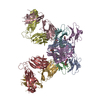
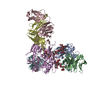
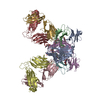
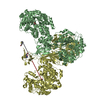

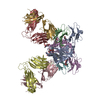


 PDBj
PDBj









